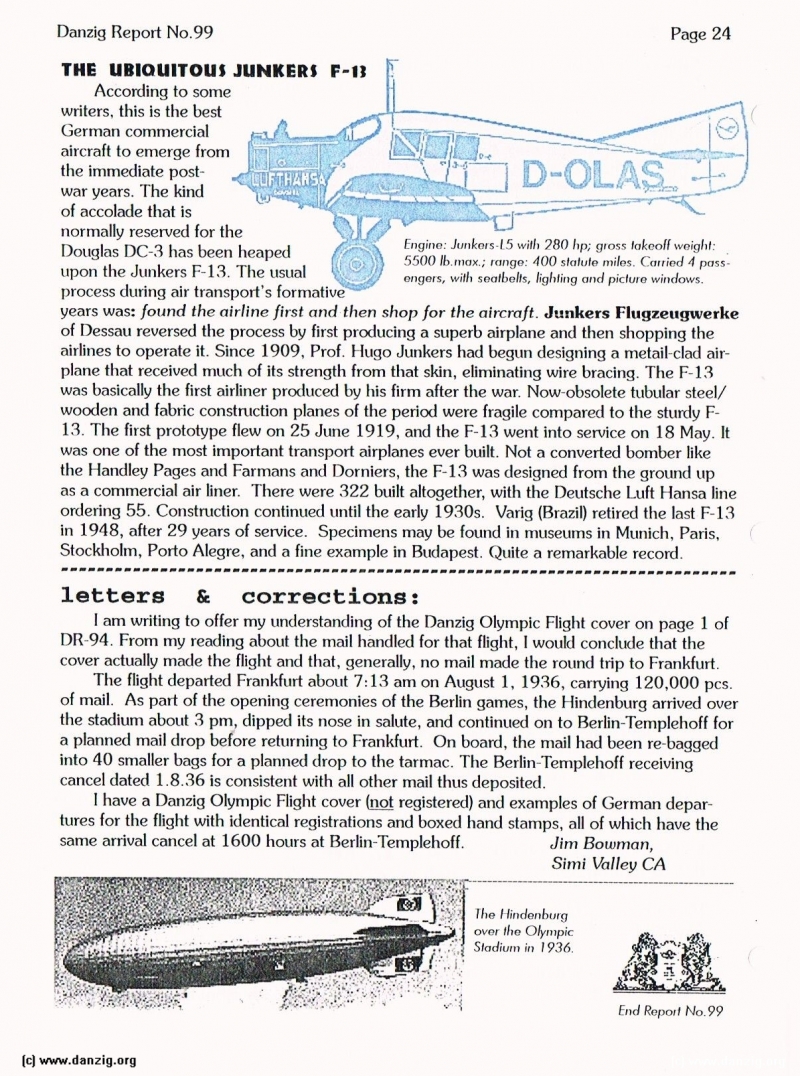Gallery » Danzig Report 99 - April, May, June 1998 » THE UBIQUITOUS JUNKERS F-13
[« Previous]
[Overview]

THE UBIQUITOUS JUNKERS F-13
According to some writers, this is the best German commercial aircraft to emerge from the immediate postwar years. The kind of accolade that is normally reserved for the Douglas DC-3 has been heaped upon the Junkers F-13. The usual process during air transport's formative years was: found the airline first and then shop for the aircraft. Junkers Flugzeugwerke of Dessau reversed the process by first producing a superb airplane and then shopping the airlines to operate it. Since 1909, Prof. Hugo Junkers had begun designing a metail-clad airplane that received much of its strength from that skin, eliminating wire bracing. The F-13 was basically the first airliner produced by his firm after the war. Now-obsolete tubular steel/ wooden and fabric construction planes of the period were fragile compared to the sturdy F-13. The first prototype flew on 25 June 1919, and the F-13 went into service on 18 May. It was one of the most important transport airplanes ever built. Not a converted bomber like the Handley Pages and Farmans and Dorniers, the F-13 was designed from the ground up as a commercial air liner. There were 322 built altogether, with the Deutsche Luft Hansa line ordering 55. Construction continued until the early 1930s. Varig (Brazil) retired the last F-13 in 1948, after 29 years of service. Specimens may be found in museums in Munich, Paris, Stockholm, Porto Alegre, and a fine example in Budapest. Quite a remarkable record.
Engine: Junkers-1.5 with 280 hp; gross takeoff weight: 5500 lb.max.; range: 400 statute miles. Carried 4 pass-engers, with seatbelts, lighting and picture windows.
letters & corrections:
I am writing to offer my understanding of the Danzig Olympic Flight cover on page 1 of DR-94. From my reading about the mail handled for that flight, I would conclude that the cover actually made the flight and that, generally, no mail made the round trip to Frankfurt.
The flight departed Frankfurt about 7:13 am on August 1, 1936, carrying 120,000 pcs. of mail. As part of the opening ceremonies of the Berlin games, the Hindenburg arrived over the stadium about 3 pm, dipped its nose in salute, and continued on to Berlin-Templehoff for a planned mail drop before returning to Frankfurt. On board, the mail had been rebagged into 40 smaller bags for a planned drop to the tarmac. The Berlin-Templehoff receiving cancel dated 1.8.36 is consistent with all other mail thus deposited.
I have a Danzig Olympic Flight cover (not registered) and examples of German depar-tures for the flight with identical registrations and boxed hand stamps, all of which have the same arrival cancel at 1600 hours at Berlin-Templehoff.
Jim Bowman
Simi Valley CA
The Hindenburg over the Olympic Stadium in 1936.
Danzig Report Nr. 99 - April - May - June - 1998, Page 24.
Hits: 3283
Added: 06/10/2015
Copyright: 2025 Danzig.org
[« Previous]
[Overview]

